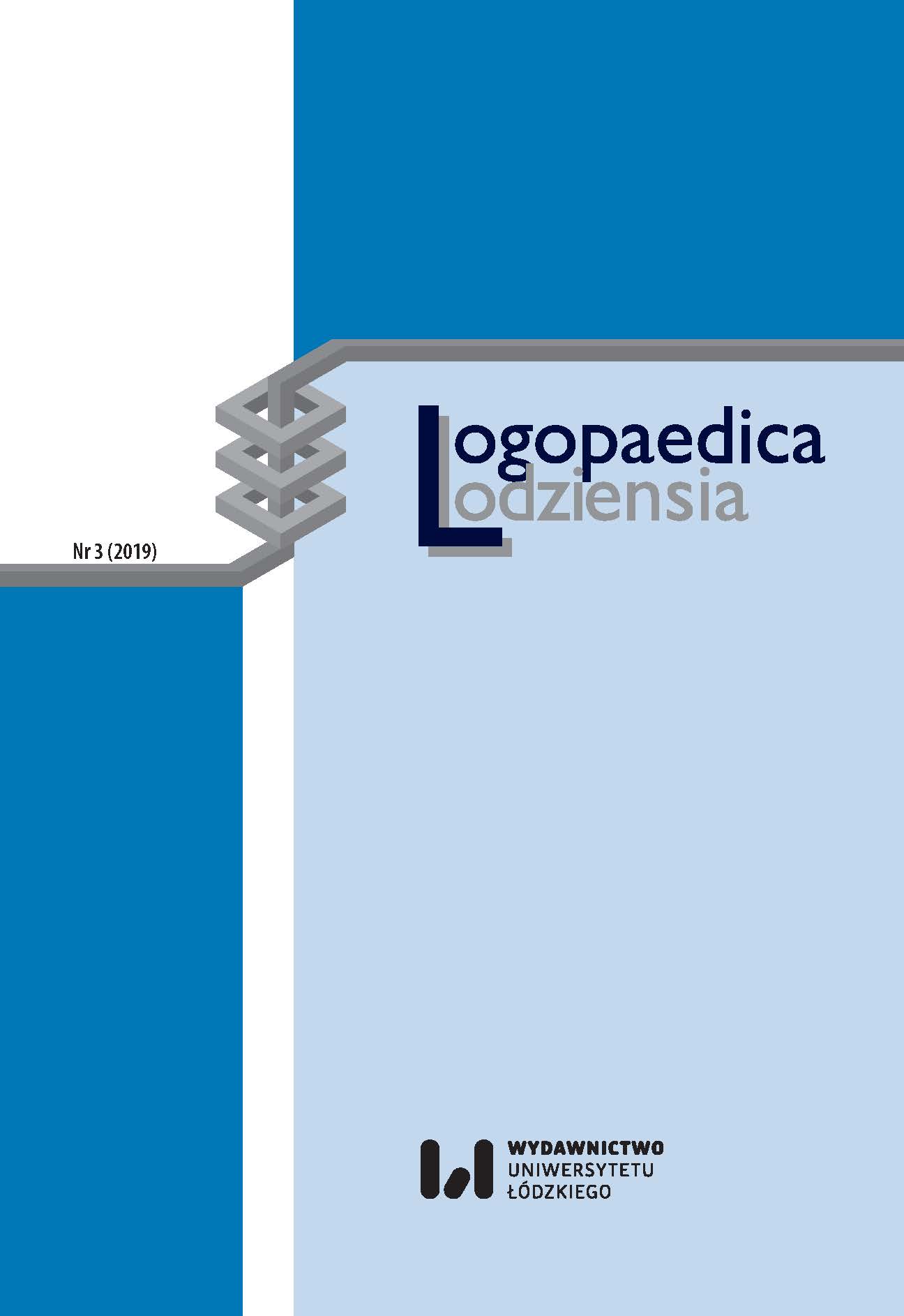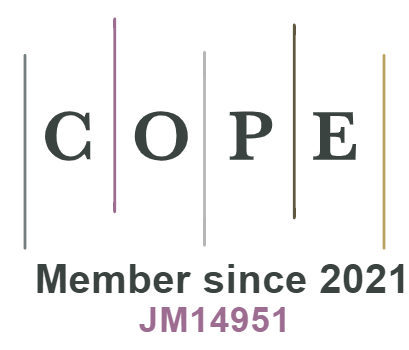Paradoksalne ruchy fałdów głosowych jako czynnościowa przyczyna duszności krtaniowej i chrypki
DOI:
https://doi.org/10.18778/2544-7238.03.09Słowa kluczowe:
paradoksalne ruchy fałdów głosowych, duszność krtaniowa, chrypka, stridor, zaburzenia psychosomatyczneAbstrakt
Paradoksalne ruchy fałdów głosowych (ang. paradoxical vocal fold movements – PVFM) to kompleksowy, heterogenny zespół objawów o zróżnicowanej etiologii i manifestacji klinicznej. Jest to zaburzenie czynnościowe, które oznacza patologiczne przywiedzenie fałdów głosowych w fazie wdechowej i/lub wydechowej, co skutkuje obturacją dróg oddechowych i dusznością. Jednostka ta może być klinicznie skrajną postacią psychosomatyzacji, w zakresie laryngologicznym prowadzącą do objawów zwężenia głośni. W artykule zaprezentowano przypadek młodej kobiety, która zgłosiła się do szpitala z powodu duszności ze stridorem oraz chrypki. Przedstawiono obraz kliniczny, diagnostykę i postępowanie terapeutyczne.
Pobrania
Bibliografia
Appelblatt N. H., Baker S. R., 1981, Functional upper airway obstruction, „Archives of Otolaryngology”, no. 107, s. 305–306.
Google Scholar
DOI: https://doi.org/10.1001/archotol.1981.00790410043011
Bahrainwala A. H., Simon M. R., 2001, Wheezing and vocal cord dysfunction mimicking asthma, „Current Opinion in Pulmonary Medicine”, vol. 7(1), s. 8–13.
Google Scholar
DOI: https://doi.org/10.1097/00063198-200101000-00002
Brown T.M., Merritt W. D., Evans D. L., 1988, Psychogenic vocal cord dysfunction masquerading as asthma, „The Journal of Nervous and Mental Disease”, no. 176, s. 308–310.
Google Scholar
DOI: https://doi.org/10.1097/00005053-198805000-00011
Brugman S.M., 2003, The many faces of vocal cord dysfunction: what 36 years of literature tell us, „American Journal of Respiratory and Critical Care Medicine”, vol. 167(7).
Google Scholar
Christopher K. L., Wood R. P., Eckert R. C., Blager F. B., Raney R. A., Souhrada J. F., 1983, Vocal‑cord dysfunction presenting as asthma, „New England Journal of Medicine”, no. 308, s. 1566–1570.
Google Scholar
DOI: https://doi.org/10.1056/NEJM198306303082605
Ciccolella D. E., Brennan K. J., Borbely B., Criner G. J., 1997, Identification of vocal cord dysfunction (VCD) and other diagnoses in patients admitted to an inner city university hospital asthma center. Abstract, „American Journal of Respiratory and Critical Care Medicine”, vol. 155: A82.
Google Scholar
Collett P. W., Brancatisano T., Engel L. A., 1983, Spasmodic croup in the adult, „The American Review of Respiratory Disease”, no. 127, s. 500–504.
Google Scholar
DOI: https://doi.org/10.1164/arrd.1983.127.4.500
Collett P. W., Brancatisano T., Konno K., 1983, Changes in glottic aperture during bronchial asthma, „American Review of Respiratory Diseases”, no. 128, s. 719–723.
Google Scholar
Dunn N. M., Katial R. K., Hoyte F. C.L., 2015, Vocal cord dysfunction: a review, „Asthma Research and Practice”, vol. 1, no. 9.
Google Scholar
DOI: https://doi.org/10.1186/s40733-015-0009-z
Faravelli C., Salvatori S., Galassi F., Aiazzi L., Drei C., Cabras P., 1997, Epidemiology of somatoform disorders: a community survey in Florence, „Social Psychiatry and Psychiatric Epidemiology”, no. 32, s. 24–29.
Google Scholar
DOI: https://doi.org/10.1007/BF00800664
Franca M. C., 2014, Differential diagnosis in paradoxical vocal fold movement (PVFM): an interdisciplinary task, „International Journal of Pediatric Otorhinolaryngology”, vol. 78(12), s. 2169–2173.
Google Scholar
DOI: https://doi.org/10.1016/j.ijporl.2014.10.003
Freedman M. R., Rosenberg S. J., Schmaling K. B., 1991, Childhood sexual abuse in patients with paradoxical vocal cord dysfunction, „The Journal of Nervous and Mental Disease”, no. 179, s. 295–298.
Google Scholar
DOI: https://doi.org/10.1097/00005053-199105000-00009
Ibrahim W. H., Gheriani H. A., Almohamed A. A., Raza T., 2007, Paradoxical vocal cord motion disorder: past, present and future, „Postgraduate Medical Journal”, vol. 83(977), s. 164–172.
Google Scholar
DOI: https://doi.org/10.1136/pgmj.2006.052522
Jain S., Bandi V., Officer T., Wolley M., Guntupalli K. K., 2006, Role of vocal cord function and dysfunction in patients presenting with symptoms of acute asthma exacerbation, „Journal of Asthma”, vol. 43(3), s. 207–212.
Google Scholar
DOI: https://doi.org/10.1080/02770900600566892
Kenn K., Schmitz M., 1997, Vocal cord dysfunction, an important differential diagnosis of severe and implausible bronchial asthma, „Pneumologie”, vol. 51(1), s. 14–18.
Google Scholar
Koek R. J., Pi E. H., 1989, Acute laryngeal dystonic reactions to neuroleptics, „Psychosomatics”, no. 30, s. 359–364.
Google Scholar
DOI: https://doi.org/10.1016/S0033-3182(89)72240-4
Koufman J. A., Block C. (2008), Differential diagnosis of paradoxical vocal fold movement, „American Journal of Speech‑Language Pathology”, vol. 17(4), s. 327–334.
Google Scholar
DOI: https://doi.org/10.1044/1058-0360(2008/07-0014)
Kramer S., Silva B. de, Forrest L. A., Matrka L., 2017, Does treatment of paradoxical vocal fold movement disorder decrease asthma medication use?, „Laryngoscope”, vol. 127(7), s. 1531–1537.
Google Scholar
DOI: https://doi.org/10.1002/lary.26416
Lacy T. J., McManis S. E., 1994, Psychogenic stridor, „General Hospital Psychiatry”, no. 16, s. 213–223.
Google Scholar
DOI: https://doi.org/10.1016/0163-8343(94)90104-X
Landwehr L. P., Wood R. P., Blager F. B., Milgrom H., 1996, Vocal cord dysfunction mimicking exercise‑induced bronchospasm in adolescents, „Pediatrics”, vol. 98(5), s. 971–974.
Google Scholar
DOI: https://doi.org/10.1542/peds.98.5.971
Lawrence S. G., 2007, Laryngeal dyskinesia: An under‑recognized condition, „Emergency Medicine Australia”, no. 19, s. 96-104.
Google Scholar
DOI: https://doi.org/10.1111/j.1742-6723.2007.00912.x
Loughlin C. J., Koufman J. A., 1996, Paroxysmal laryngospasm secondary to gastroesophageal reflux, „Laryngoscope”, no. 106, s. 1502–1505.
Google Scholar
DOI: https://doi.org/10.1097/00005537-199612000-00011
Martin R. J., Blager F. B., Gay M. L., Wood R. P., 1987, Paradoxic vocal cord motion in presumed asthmatics, „Seminars in Respiratory Medicine”, no. 8, s. 332–337.
Google Scholar
DOI: https://doi.org/10.1055/s-2007-1012672
Mathers‑Schmidt B. A., 2001, Paradoxical Vocal Fold Motion: A Tutorial on a Complex Disorder and the Speech‑Language, „American Journal of Speech‑Language Pathology”, vol. 10(2), s. 111–125.
Google Scholar
DOI: https://doi.org/10.1044/1058-0360(2001/012)
Morris M. J., Allan P. F., Perkins P. J., 2006, Vocal cord dysfunction, „Obstructive Airways Disease”, no. 13, s. 73–86.
Google Scholar
DOI: https://doi.org/10.1097/01.cpm.0000203745.50250.3b
Morris M. J., Deal L. E., Bean D. R., Grbach V. X., Morgan J. A., 1999, Vocal cord dysfunction in patients with exertional dyspnea, „Chest”, no. 116, s. 1676–1682.
Google Scholar
DOI: https://doi.org/10.1378/chest.116.6.1676
Morrison M., Rammage L., Emami A. J., 1999, The irritable larynx syndrome, „Journal of Voice”, no. 13, s. 447–455.
Google Scholar
DOI: https://doi.org/10.1016/S0892-1997(99)80049-6
Newman K. B., Mason U. G., Schmaling K. B., 1995, Clinical features of vocal cord dysfunction, „American Journal of Respiratory and Critical Care Medicine”, no. 152, s. 1382–1386.
Google Scholar
DOI: https://doi.org/10.1164/ajrccm.152.4.7551399
Ng T. T., 2017, The forgotten cause of stridor in the emergency department, „Open Access Emergency Medicine”, vol. 16, no. 9, s. 19–22.
Google Scholar
DOI: https://doi.org/10.2147/OAEM.S125593
Niven R. M., Roberts T., Pickering C. A., Webb A. K., 1992, Functional upper airways obstruction presenting as asthma, „Respiratory Medicine”, vol. 86(6), s. 513–516.
Google Scholar
DOI: https://doi.org/10.1016/S0954-6111(96)80013-8
Patel R. R., Venediktov R., Schooling T., Wang B., 2015, Evidence‑Based Systematic Review: Effects of Speech‑Language Pathology Treatment for Individuals with Paradoxical Vocal Fold Motion, „American Journal of Speech‑Language Pathology”, vol. 24(3), s. 566–584.
Google Scholar
DOI: https://doi.org/10.1044/2015_AJSLP-14-0120
Patterson R., Schatz M., Horton M., 1974, Munchausen’s stridor: non‑organic laryngeal obstruction, „Clinical & Experimental Allergy”, vol. 4(3), s. 307–310.
Google Scholar
DOI: https://doi.org/10.1111/j.1365-2222.1974.tb01390.x
Powell D. M., Karanfilov B. I., Beechler K. B., Treole K., Trudeau M. D., Forrest A., 2000, Paradoxical vocal cord dysfunction in juveniles, „Archives of Otolaryngology – Head and Neck Surgery”, no. 126, s. 29–34.
Google Scholar
DOI: https://doi.org/10.1001/archotol.126.1.29
Ramírez R. J., León I., Rivera L. M., 1986, Episodic laryngeal dyskinesia: Clinical and psychiatric characterization, „Chest”, no. 90, s. 716-721.
Google Scholar
DOI: https://doi.org/10.1378/chest.90.5.716
Rhodes RK., 2008, Diagnosing vocal cord dysfunction in young athletes, „Journal of the American Association of Nurse Practitioners”, vol. 20(12), s. 608–613.
Google Scholar
DOI: https://doi.org/10.1111/j.1745-7599.2008.00363.x
Roca M., Gili M., Garcia‑Garcia M., Salva J., Vives M., Garcia Campayo J., Comas A., 2009, Prevalence and comorbidity of common mental disorders in primary care, „Journal of Affective Disorders”, no. 119, s. 52–58.
Google Scholar
DOI: https://doi.org/10.1016/j.jad.2009.03.014
Rundell K. W., Spiering B. A., 2003, Inspiratory stridor in elite athletes, „Chest”, no. 123, s. 468–474.
Google Scholar
DOI: https://doi.org/10.1378/chest.123.2.468
Skinner D. W., Bradley P. J., 1989, Psychogenic stridor, „Journal of Laryngology and Otology”, no. 103, s. 383–385.
Google Scholar
DOI: https://doi.org/10.1017/S0022215100109028
Stoelting R. K., 1987, Pharmacology and physiology in anesthetic practice, Lippincott, Philadelphia.
Google Scholar
Tajchman U. W., Gitterman B., 1996, Vocal cord dysfunction associated with sexual abuse, „Clinical Pediatrics”, vol. 35(2), s. 105–108.
Google Scholar
DOI: https://doi.org/10.1177/000992289603500211
Vertigan A. E., Theodoros D. G., Winkworth A. L., Gibson P. G., 2008, Acoustic and electroglottographic voice characteristics in chronic cough and paradoxical vocal fold movement, „Folia Phoniatrica et Logopaedica”, vol. 60(4), s. 210–216.
Google Scholar
DOI: https://doi.org/10.1159/000136902
Waal M. W. de, Arnold I. A., Eekhof J. A., Hemert A. M. van, 2004, Somatoform disorders in general practice: prevalence, functional impairment and comorbidity with anxiety and depressive disorders, „British Journal of Psychiatry”, no. 184, s. 470–476.
Google Scholar
DOI: https://doi.org/10.1192/bjp.184.6.470
Zelcer S., Henri C., Tewfik T. L., Mazer B., 2002, Multidimensional voice program analysis (MDVP) and the diagnosis of pediatric vocal cord dysfunction, „Annals of Allergy, Asthma & Immunology”, no. 88, s. 601–608.
Google Scholar
DOI: https://doi.org/10.1016/S1081-1206(10)61892-3
Pobrania
Opublikowane
Jak cytować
Numer
Dział
Licencja

Utwór dostępny jest na licencji Creative Commons Uznanie autorstwa – Użycie niekomercyjne – Bez utworów zależnych 4.0 Międzynarodowe.












